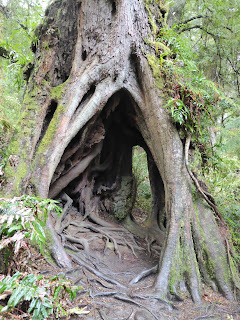So my last post finished with an overnight stop at Apollo Bay. We hadn't travelled as far along the Great Ocean Road as I had hoped we would. I thought we might have stayed overnight in Princetown or Port Campbell, close to the Twelve Apostles so we could view them at first light. There were just so many opportunities to stop & view the coastline, plus the winding roads & reduced speed limits, that it just didn't happen according to plan. So, we were on a mission, as I had a class at Savour at 5.30pm, helping out on a macaron class.
This morning was, disappointingly, drizzly. It had continued to rain quite heavily during the night.
Apollo Bay
Apollo Bay is set against the backdrop of the Otway foothills. It has the only commercially operated harbour on the Great Ocean Road. The harbour has a large breakwall protecting it from the waters of Bass Strait.
Photo: a panorama shot of Apollo Bay's beach, town & harbour
We left Apollo Bay around 7.30am. The Great Ocean Road deviates away from the coast at this point & the speed limit increases to 100km/h.
Mait's Rest
This is a stop about 10km on from Apollo Bay, with a rainforest walk. The vegetation differed slightly to the rainforest we experienced at Erskine Falls in that it contained huge tree ferns with undergrowth ferns, golden ash & monstrous ancient myrtle beech.
Cape Otway
Cape Otway is situated 30km west of Apollo Bay, where Bass Strait & the Southern Ocean meet. Cape Otway is about 12km off the Great Ocean Road & is famous for the Cape Otway Lightstation. The lighthouse was constructed in 1846 after 8 ships were wrecked along the coast & hundreds of lives were lost. It is the oldest lighthouse on mainland Australia, though it is no longer functional as a lighthouse, having been decommissioned in 1994. It has been replaced by a solar-powered automatic beacon which stands approx. 2m off the ground & is only visible to a distance of 30km. The beacon of the old lighthouse could be seen from a distance of 48km, though this may be due to it standing 20m higher than the new light.
The on-shore wind on the ground was estimated at 27 knots by one of the lighthouse attendants. At the top of the lighthouse, the wind force was just phenomenal. You really had to brace yourself against it.
Cape Otway also housed Australia's first telegraph station, built in 1859, after a submarine telegraph cable was built between the mainland & Tasmania. The cable failed after approx. 18 months & the building became a Lloyd's signal station, signalling passing ships & relaying the details to Melbourne. The building has also served as a school & accommodation for soldiers & the lightkeeper's family.
In 1942, a radar bunker was added to the site after the US steamship "City of Rayville" was sunk off the cape by a German mine in 1940. The sinking was the USA's first casualty during WWII.
Cape Otway still serves as a weather station for the Australian Bureau of Meteorology, the weather being monitored 24 hours a day, 365 days per year.
The Twelve Apostles
Honestly, there are no words to truly describe the majesty & beauty of the Twelve Apostles. These limestone rock formations that rise up out of the waves to tower over the sea really are the highlight of the Great Ocean Road. There was only ever 10 formations, but the effects of erosion from the elements has reduced their number to 8, though some say 7. They are able to be viewed from numerous viewing platforms. I'll let the pictures do the talking....
The weather was rather dismal all morning which was disappointing, as Glenn & I were wanting to do a helicopter flight over the Twelve Apostles. As luck would have it, the weather brightened when we returned to the car park. 10 minutes later we were in the air. Amy, our pilot, said we were travelling at 208km/h, but it honestly felt like we were barely moving, maybe due to the huge headwind. We travelled 45km over the Twelve Apostles, Loch Ard Gorge & down to London Bridge, all covered in 15 min. Absolutely amazing! Spectacular!
The Great Ocean Road truly is a lesson in contrast along this section of the road. On one side, you have the rugged coastline & on the other, you have lush green pastures & rolling plains.
Photo: those white specks are sheep
Loch Ard Gorge
Loch Ard Gorge lies about 10km west of the Twelve Apostles & is also a natural feature carved through the action of water. It is named after the ship, the Loch Ard, that ran aground near Muttonbird Island in 1878. Only 2 of 54 passengers survived.
This brought a premature end to our Great Ocean Road journey, as we needed to get back to Melbourne. Our trip inland, from Port Campbell to Melbourne revealed lush, green pastures & rolling hills.
Our aim is to one day return to complete the section between Loch Ard Gorge & Allansford & onto Warnambool.
If anyone is considering doing the Great Ocean Road, I would seriously recommend a minimum of 3 days if you are interested in stopping at all the coastal villages or doing one of the many walking trails to rainforests, waterfalls or lookouts.




















No comments:
Post a Comment